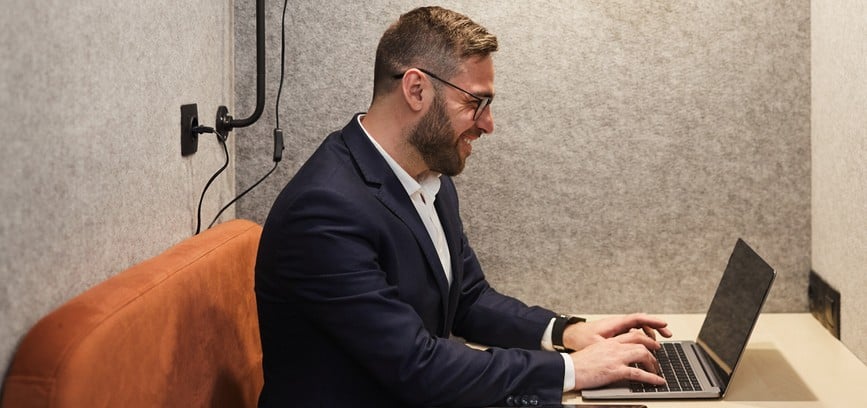We see the current climate in Australia as ‘yoyoing’ between working in the office and remotely, all dependent on something largely out of our control. So how can businesses build the necessary resilience to overcome these challenges and come out the other side stronger and more successful?
To answer these questions and more, we spoke with resilience expert, Heidi Dening. Heidi shared some valuable insights on workplace resilience – what it is and why it is important in the current working conditions. She also provided practical strategies on how to build resilient teams and explored what to focus on when designing the office to support workplace resilience.
Resilience has often been defined by the ability to bounce back…but is it?
“I believe resilience is really defined by somebody or a place’s ability to bounce forward, to be able to learn something from the challenge that we have gone through, be able to adapt it to what the new norm is going to be for that workplace, and be able to progress forward, to move forward, to bounce forward.”
– Heidi Denning.
Workplace resilience is often defined as the ability to bounce back from setbacks and handle difficult experiences or events. For the past 18 months, many organisations have been focused on resilience and in building resilient workplaces. They want to navigate through the challenges and changes brought about by the pandemic – until things go back to ‘normal’. If they can survive and bounce back, then the business would be considered a resilient business.
However, Heidi has a different view on resilience. She doesn’t believe we should “measure a person or a workplace by their ability to bounce back.” We all go through fundamental changes when experiencing challenges or adversities in life and at work. Even at a cellular level, we don’t really go back to the way things were.
We have to adapt to the changes and keep moving forward – to learn from what we, our customers, employees and partners are going through; and not crave that stability and safety we felt before the pandemic began.
The ‘yoyo’ working environment in Australia
With all the lockdowns over the past 18 months, the climate in Australian workplaces can be described as ‘yoyoing’ from between working in the office and remotely. How is this affecting workers?
“It’s chipping away at them. Without a doubt,” says Heidi. The current ‘yoyo’ climate is forcing people to adapt to the new normal – working at the office when allowed to do so, and going back to remote working when lockdowns happen. To survive and still get things done, most employees need to change their lifestyles and implement new working habits. The bottom line, everyone is feeling overwhelmed, stressed and exhausted. This makes resilience in the workplace more important than ever in the current yoyo environment.
Why workplace resilience is important
Heidi highlighted that resilience in the workplace allows for creativity and innovation. The future is definitely unpredictable and unknown – but resilience enables you to move forward and think outside the box. It empowers you to do something new, different and unique.
Resilient teams adapt quicker to the new ways of working, and figure out ways to be more collaborative and productive in a virtual environment. And when leaders build resilient workplaces, it’s a lot easier for them to create new business models, adopt new technologies, and develop new and innovative ways to deal with customers. All these help the business not only survive, but thrive in this uncertain and ever-changing world.
“When you have developed your resilience muscle, you’re actually developing your creativity and innovation muscle. I think this is the greatest benefit for a workplace.”
Building a ‘culture of care’ to help teams be more resilient
Now that we know how important resilience is in this current climate, how can leaders deliver a positive support experience for employees working remotely? Heidi has provided us with a number of ways employers can create a ‘culture of care’ to help teams be more resilient.
Be vulnerable and authentic
As a leader, you always want to appear strong, happy and confident. And sometimes, you need to be but during these uncertain and challenging times, your team also wants to see the ‘human’ side of you. Be vulnerable and authentic enough to admit that working from home is not always easy – that homeschooling and being locked in with your partner is sometimes difficult and can drive you nuts. This way, your team can feel that they’re not alone when they feel stressed and overwhelmed. So others feel okay to say, “I’m not okay.”
Bring a sense of calmness
Yes, you can be vulnerable and say you’re not at your peak at certain moments, but as a leader, you also need to show the team that you are calm and in control. Heidi stressed that “bringing that sense of calm in a world that’s feeling very unsettled is definitely important.”
Deliver relevant and accurate information
In times of crisis, most employees are inundated by news that they get from the media and from friends, families and even colleagues. However, this information can be inaccurate or totally untrue. Leaders need to be able to disseminate information that is relevant and accurate. They have to figure out what’s real and what’s not – and deliver that information to the team in a timely way.
Be a visionary
Your team will look to you for assurance and guidance. They will depend on you to create a path through this crisis. As a leader, you need to be a visionary – not in such a way that you can predict the future – but in a way that assures the team “we have what it takes to adapt and we’re going to be okay in this new world.”
Stay connected with your team
Heidi highlighted the need for leaders to “know what to look for, to make sure the team’s doing okay, virtually.” You have to know how people are going. So, make sure you stay connected with your team, through messaging, text or phone. If you would like to learn more about whether your team are resilient enough to cope with all the stress and uncertainty, take this short quiz.
How the office can support resilience
The long-term view is that most workplaces will have a hybrid working environment, where employees divide their time between the office and working remotely. So, the physical workplace may look different in the future, but would still play an important role in building resilient teams.
According to Heidi, there are a number of factors that impact resilience in the office:
Lighting
Light decisions in the workplace can make a huge difference in a person’s ability to sleep well. And sleeping well helps employees to be more productive and perform better during the day. Of course the opposite is also true, and a person will feel tired, exhausted and unable to perform his/her best, if he/she gets even just one bad night’s rest.
Noise
“Sound is another one, because distraction at work is something that really chips away at our ability to work well.” Heidi noted that when people get distracted, whether it’s because of the sounds around the office or colleagues talking, it can really stress them out. Some are good at zoning out by wearing headphones or simply focusing intently on their work. But the majority of people struggle with sound distractions.
Technology
Technology has a big impact on resilience in the workplace. Whether employees are working at the office or at home, they need the right tools and technology to be able to do their jobs properly. Having the wrong type of tech or if things just don’t work, this can be a source of frustration and stress. “If you’re ambitious, and you want to get things done in a particular time without mistakes, then you need the tech to do that. And if you can’t, again, it’s just chipping away at someone’s ability to work.”
Social spaces
When designing your office, it’s important to create spaces that build connections between people. “Social health is so crucial for a team’s culture.” Heidi mentioned that employees go to the office to connect and collaborate with colleagues – to have a laugh and share life stories. “For many people who live by themselves or in really bad relationships, or, you know, lots of things going on in the background, the workplace can be such a sanctuary.” So, the office needs to be designed in a way that it allows social connection between teams and employees.
Axiom recently worked with ELMO, one of the fastest-growing HR tech companies in the Asia-Pacific region, to build a workspace that would foster connection and community engagement. The office design included a café and community space where staff can relax and socialise, and a wellness room where they can practise yoga and meditation.
If you’d like to learn more on how to better prepare your business and workplace for the future of work, read our Progressive Leader’s Guide to the Future of Work in Australia.






